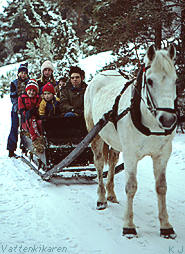Air pollutants like nitrogen
oxides and many other chemical compounds originate from a great many
industries. Built-up areas produce large amounts of exhaust fumes
that contain nitrogen oxides and in many western countries, automobiles
are responsible for between 40%-80% of the total discharge of nitrogen
oxides, but the use of catalysators can reduce the discharge by 70%-75%.
Even with the use of fossil fuels such as coal and oil for energy
production results in nitrogen oxides.

This is a fun and non-polluting way to travel, but is not always
felt to be quick and effective.
|
To do something about the
discharge of nitrogen oxides into the atmosphere, several steps that
are partly related to each other need to be taken:
increasing energy saving and making energy exchange
more efficient, especially in the eastern states of Europe.
cleaning of discharge from the burning of fossil fuels
before it is released into the atmosphere.
replacing the use of fossil fuels with renewable energy
sources such as solar and vind power and biomass
(composting, etc).
reducing automobile usage and speed (a car travelling
at 120 km/h produces four times as much nitrogen oxide as a car
travelling at 60 km/h)
the developement of a more environmentaly sound fuel,
making engines more energy conserving and efficient.
There are different methods, with varying degrees
of efficiency and advancment, to reduce the discharge of nitrogen
oxides with the burning of fossil fuels. But the best and most logical
way to reduce discharge is by reducing the use of fossil fuels.
|


